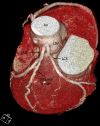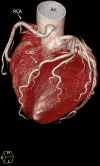The prevalence of coronary anomalies in a single center of Korea: origination, course, and termination anomalies of aberrant coronary arteries detected by ECG-gated cardiac MDCT
- PMID: 24725604
- PMCID: PMC3991863
- DOI: 10.1186/1471-2261-14-48
The prevalence of coronary anomalies in a single center of Korea: origination, course, and termination anomalies of aberrant coronary arteries detected by ECG-gated cardiac MDCT
Abstract
Background: Coronary anomalies are rare congenital abnormalities often found incidentally on conventional coronary angiography (CCA) or coronary CT angiography (CTA). They may result in various clinical outcomes. CCA is invasive and not able to demonstrate all coronary anomalies in detail, especially those with complex courses. Multidetector computed tomography (MDCT) enables visualization of the origin and course of coronary arteries. The objective of this study was to investigate the prevalence of origin and termination coronary artery anomalies and the course of these anomalies in patients in a single center in Korea.
Methods: To diagnose coronary anomalies, the angiographic data of 8,864 consecutive patients undergoing 64- or 320-MDCT from September 2005 to November 2011 were analyzed retrospectively.
Results: Among the 8,864 patients, 103 (1.16%) had coronary anomalies. Ninety (87.4%) patients had origin and distribution anomalies, and 13 (12.6%) patients had a coronary artery fistula. The most common anomaly (41, 39.8%) was an anomalous origin of the right coronary artery (RCA). Of these, three patients received a coronary artery bypass graft.
Conclusions: The prevalence of coronary anomalies in a single center of Korea was 1.16%. The incidence and patterns of coronary artery anomalies in our patient population were similar to those of previous studies.
Figures







References
-
- Kardos A, Babai L, Rudas L, Gaál T, Horváth T, Tálosi L, Tóth K, Sárváry L, Szász K. Epidemiology of congenital coronary artery anomalies: a coronary arteriography study on a central European population. Cathet Cardiovasc Diagn. 1997;42(3):270–275. doi: 10.1002/(SICI)1097-0304(199711)42:3<270::AID-CCD8>3.0.CO;2-9. - DOI - PubMed
MeSH terms
LinkOut - more resources
Full Text Sources
Other Literature Sources

